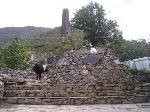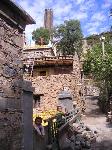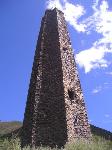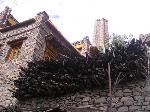- Getting around Lijiang. Dont stay in the Old Towns more than 2 days, there is nothing to do. KRISS Oct 9, 2013 05:46
- 2013 Beijing Temple Fair BENNYLAU Feb 26, 2013 03:29
- Malaysian traveling from KUL - LAX vis Shanghai PVG ZATI_DY Jan 3, 2013 20:15
The Stars of Songgan_ Maerkang
- Views: 5416
- |Vote: 0 0
- |Add to Favorites
- |Recommend to Friends
The small village appears deserted. Two cows wander shyly, purposefully down the stone stairs expecting us to make room for them to pass. A woman with a basket of fodder on her back makes her way home barely giving us a glance. The mournful strains of drum and rhythmic chanting drift from somewhere within the village proper but there is no sign of any public place of worship. The sky is clear and the air is cool – not yet warmed by the morning sun. Prayer flags on poles staked in the ground flutter briskly in the breeze.
One cannot journey through this valley and not be impressed by the sight of Songgan. An otherwise insignificant village like all the rest we pass through it is however singularly unique. Songgan boasts an impressive four stone watch towers dating back some 200 to 300 years. The towers of Songgan command your attention. They are like none I have seen elsewhere. Of the four, two of them are square towers, ordinary and typical of the region and stand some distance off across the valley. But the two towers in the village – one above and one below – are a surprising work of engineering. These eight point towers are in fact star shaped with a base diameter of 8m tapering to one meter at their respective peaks of 24 and 29 meters.
After the cows have passed, we climb the stairs, dominated by a three-tiered stone cairn, which should be circled three times before entering the village. The cairn is decorated with sheets of stone inscribed – possibly with matras – in the fluid Tibetan script. To our right is the lower tower. Steep chunky stairs wind around the base climbing a few meters to the weathered timber framing of the entrance where a door once hung. Inside with blackened walls is a small chamber. Holes in the floor and ceiling where ladders once gave access to upper and lower levels disappear into darkness. The irregular stones are carefully laid with the external wall precisely flush – each sharp angle of the star pronounced against the sky.
The single lane through the village is narrow and quite empty. We walk slowing taking in the rustic simplicity of the dry stone masonry, timber chopped and stacked for firewood, a decorative front door, corn stalks drying up against the wall, ferns overflowing from the roof, a window box of fuchsia in a wild profusion of pink, and regiments of harvest corn basking golden in the sun. At the sound of our voices two small children scramble to climb the fence for a better look. With bright red cheeks on dirty chubby faces they peer down the lane. The older children, three teenage boys watch from the steps of their home. Later two of them follow us up the narrow and steep path. We exchange smiles and a few simple questions. One disappears inside to get something for us and comes back with a Buddhist painting known as a Thangka.
Of the boys, both aged about 15 and good friends, one is a student and the other a monk. While catching our breath at the top of this short climb the student tells me an interesting story. A recent legend has it that a tunnel runs from the base of the lower tower to the stream that flows beside it and through this the villagers were able to escape during the conflict with the Japanese. As I tried to piece together the little I could understand a young woman brandishing a walkie-talkie comes bounding up the hill greeting me enthusiastically in English. Taking her for a tour guide – her group would surely soon follow – I asked her if she could help with some translation of this intriguing little legend. However she rather rudely suggested that the lad would know nothing and it was all just a myth.
At this juncture she is joined by her group, three companions, also each carrying a walkie-talkie – in case they should lose sight of and contact with each on their hike to the top of this rather small mountain. I thought the lad, being a local probably knew a thing or two – myth or no myth – and could barely contain my mirth as she and her friends bid a cheerful farewell before disappearing into the bush, never to be seen again – at least not by us. What ever happened to mobile phones??? Now I doubt the Japanese ever set foot in the valley but it was touched by the civil war that raged around them and so there may be some truth in the lad’s story.
The Suomo River, dammed for power and dredged for gravel flows with less volume and vigor beneath the towers of Songgan but continues to wind it’s torturous way westward through the mountains. The peaks surrounding are not so tall and the valley is broader and flatter. Locals live a relatively simple life, raising pigs and growing corn on the surrounding land and small cropping in the gardens around their houses. Along the valley flats scores of new homes are being built to replace the older ones perched high up on the ridges of surrounding peaks. The stone is quarried locally from the rugged mountains and each of these large three story houses of the Jiarong take around six weeks to complete.
It's refreshing, despite the pressure to modernize that these new homes retain the same internal and external characteristics as their predecessors. Where many other villagers throughout the country have traded the rustic beauty of their traditional old homes for that omnipresent symbol of affluence – the concrete block with the white tile façade – the Jairong are following their own traditions. They are retaining the decorative art of their lintels, doors and gates and the distinctive white wash trims – an echo of their temple art and worship and a simple but colourful lifestyle. The mysterious towers of Songgan are silent these days with their history safely hidden in their stones.
Getting there:
Songgan is about 20kms from Maerkang on the road to Danba Y5 each way on the local bus.
There is no accommodation in the village and only one small kiosk selling snacks and drinks







 Copyright © 1998-2026 All rights reserved.
Copyright © 1998-2026 All rights reserved.